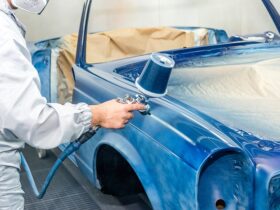No products in the cart.
How to Properly Take Care of Your New Car

Car care and maintenance is a task that you should take seriously. Otherwise, you will be flushing money in the gutter on repairs and replacements that could be avoided with regular checkups at a fraction of the cost. (Image Credit: Dariusz Sankowski/Pixabay)
A new car requires less frequent services because annoying servicing such as changing breaker points, cleaning body rust, and replacing spark plugs are associated with aging. However, your new automobile still needs periodic checks, clean up, and repair work. Let’s look at some of the ways to take care of your car.
1. Windshield
The windshield is an important safety feature in your car, and it plays the following roles.
- Protect you from harsh weather conditions
- In the event of an accident, the windshield prevents the driver and the passenger from being ejected from the car
- It provides support for the airbags
- It provides support for the roof in case of a rollover, preventing it from collapsing
Keeping your vehicle’s windshield in good condition will help you enjoy the numerous safety features it offers. Laminated windshields are recommended as they assure safety. To protect your windshield from breaking and costs associated with windshield replacement. The replacement, especially, can be overwhelming and complex if you fail to involve a professional. Thankfully, with the internet, today, you can easily spot an experienced auto shop near you to get the job done. Professionals often advise that you resist using harsh chemicals when cleaning it. Do not use ammonia-based chemicals as they emit dangerous fumes that could crack the glass. Windshield cleaner with a unique formula will keep your view clear and protect the glass to ensure long life. Always park your car in a parking garage or in the shade to keep your vehicle at a constant temperature, especially during winter and summer.
2. Engine oil
It is essential to check the engine level regularly and look out for a leak. So, what’s the procedure to check the engine oil? It’s straightforward and you don’t need a mechanic to assist. One thing to note is that when checking the engine oil, you need to park the vehicle on a flat surface to get the correct reading. Usually, a dipstick is used to check the levels. If the oil level is low, fill the tank but don’t overfill it. In case you find a leak, repair it immediately.
3. Examine the brakes
You need to be a pro to examine the brakes. Otherwise, take your vehicle to a servicing shop. Ensure your vehicle is checked at least two to three times a year, and more if your vehicle goes for long distances. To check the brakes, you will need to remove the wheels and examine the condition of the drums, rotors, and pads.
4. Transmission fluid
In most new models with an automatic gearbox, the cap to the transmission fluid cylinder is sealed. If your car is not sealed, you can check the fluid level when your vehicle’s engine is warmed up and running. It is important to check the level of the power-steering pump and the brake fluid reservoir. If you notice a leak, repair the system, and if the fluid level is low, full up the tanks.
5. Wash your car
Washing is the easiest, yet most tiresome way of taking care of your car. Cleaning the interior and exterior of the car is important. If possible, clean the body every week, ensuring to remove dirt and corrosion from the undercarriage and fender wells.
Spilled liquids such as juices and sodas are corrosive, while dirt particles can be abrasive. Vacuum the interior of the car and wipe the dashboard with a soft, wet cloth.
6. Clean the mats
Take your mats outside and hose or brush them to remove dirt that may otherwise lead to wear and tear if it builds up. Dry the mats before placing them back. It is advisable to clean your vehicle’s engine at least once a year.
7. Clean the engine
A clean engine enables you to spot leaks easily and service the engine components. If you are a pro, you can clean the engine by yourself. Otherwise, have your vehicle steam cleaned.
8. Clean the glasses
The headlights, rear-view mirrors, and the windshield need regular cleaning as dirt could lead to safety hazards. Cleaning fluid and a wiper are used to clean dirty rear-view mirrors and the windshield. For a temporary headlight fix, use baking soda or toothpaste, and for a permanent solution, use a UV-resistant clear coat.
Owning a car is a great achievement, but taking care of it requires a lot of hard work. A new car has to be maintained to ensure reliability and avoid breakdowns. Performing regular maintenance will help you extend the life of your car and ensure peak performance. Regular car care will also save you money in repairs.










Leave a Reply